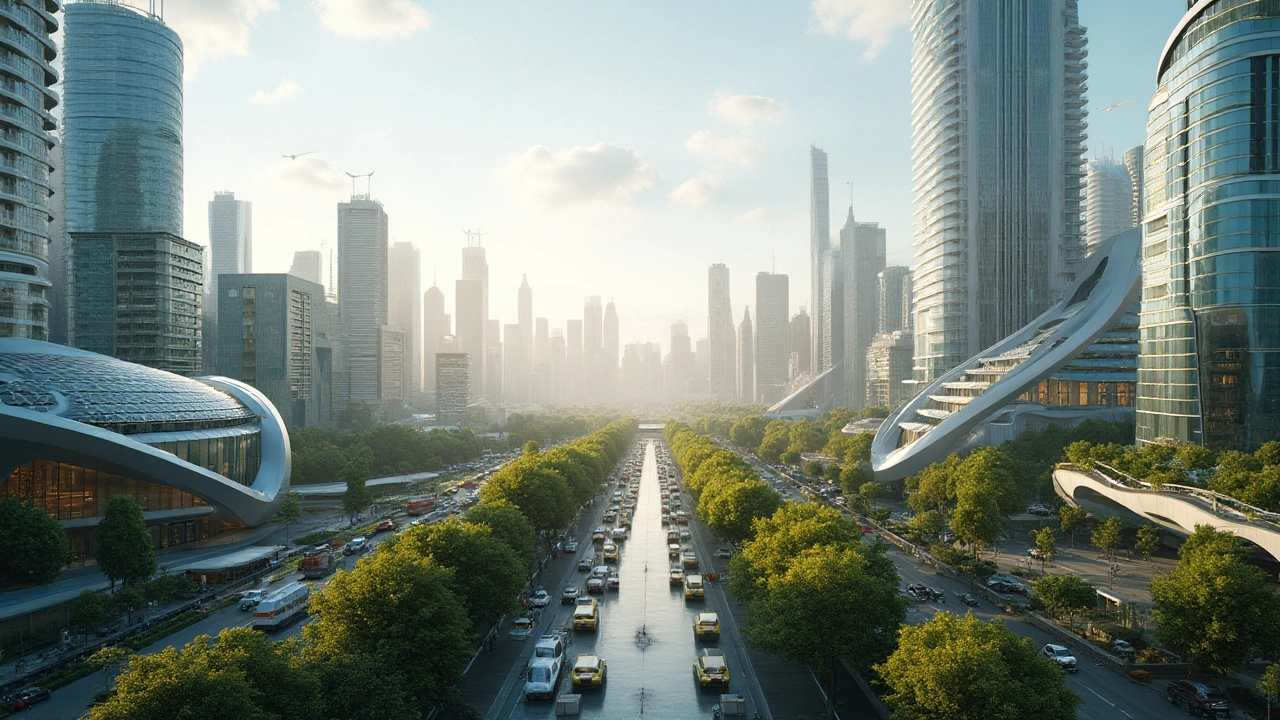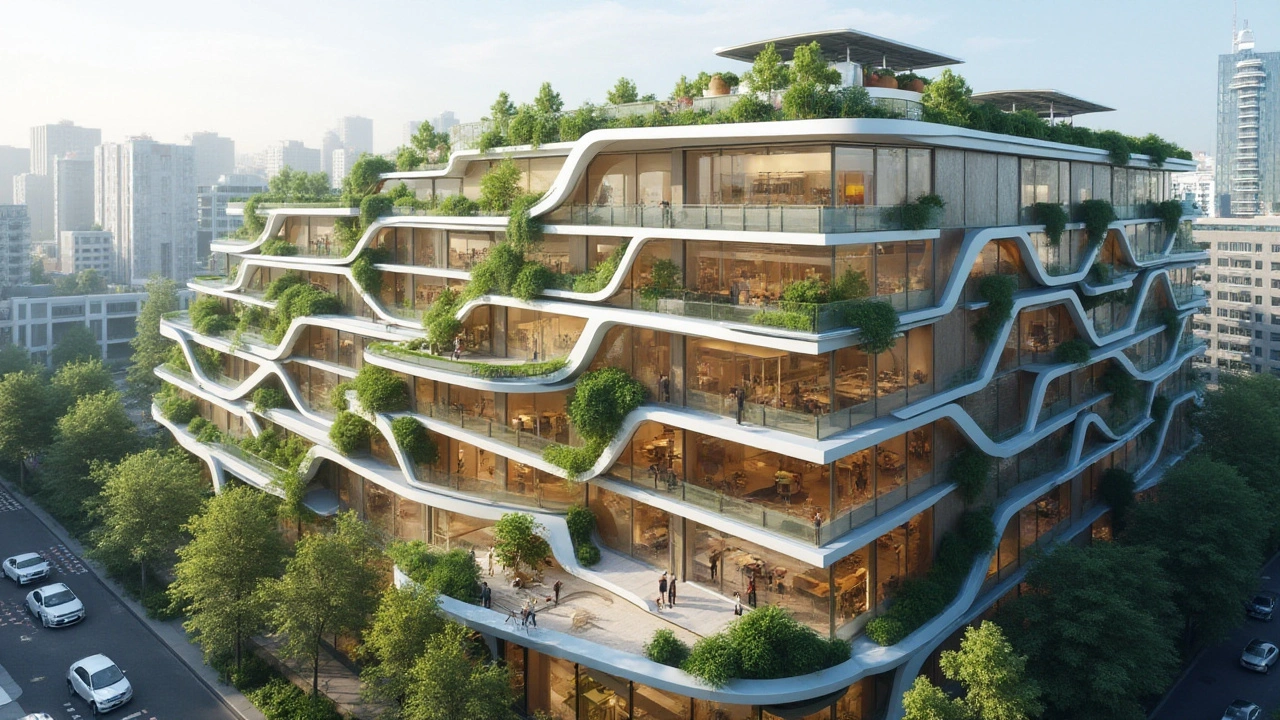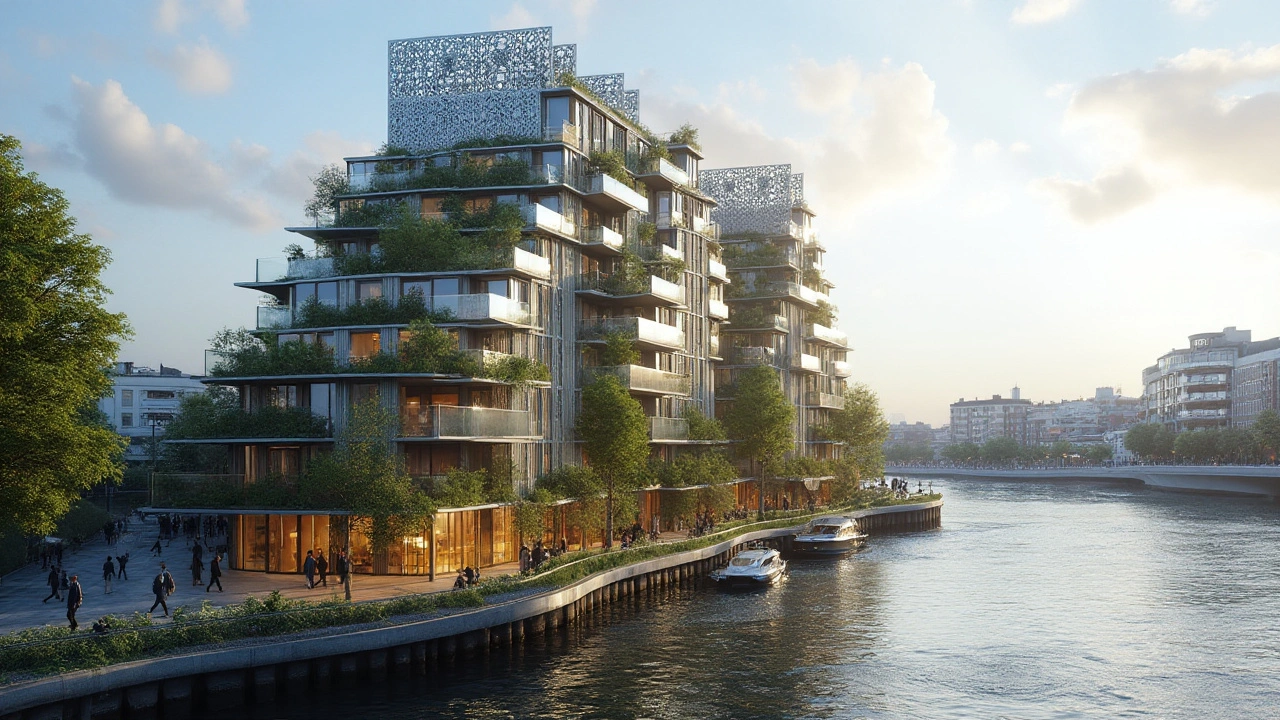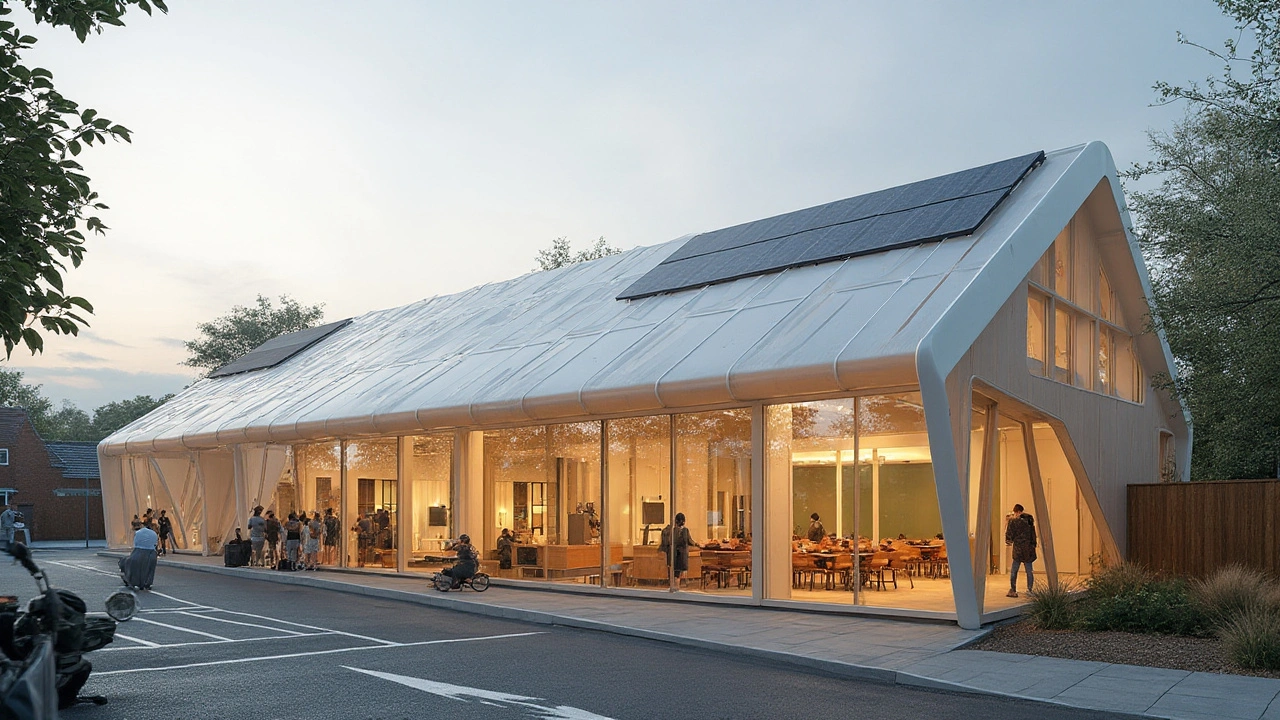Revolutionizing Design: The Rise of High-Tech Architecture
 Oct, 14 2024
Oct, 14 2024
Imagine stepping into a world where buildings seem to breathe, adapt, and resonate with the pulse of our modern era. This isn't just an architect's dream— it's the reality of high-tech architecture. These cutting-edge designs are transforming our cities and redefining what it means to inhabit a space in the 21st century.
Originating in the late 20th century, high-tech architecture merges sophisticated engineering with bold design, producing structures that not only catch the eye but also serve practical, often sustainable purposes. As technology continues to evolve, so too do the possibilities within architecture, leading us into a new era of building that’s as innovative as it is functional.
From transparent façades that allow natural light to flood interiors, to smart systems that adjust energy usage, the features of high-tech architecture are as varied as they are groundbreaking. These buildings aren't just about looking futuristic; they're about integrating technology into the very fabric of how buildings operate and interact with their environment.
- The Origins of High-Tech Architecture
- Key Features and Principles
- Innovative Materials and Technologies
- Impact on Urban Landscapes and Sustainability
The Origins of High-Tech Architecture
The seeds of high-tech architecture were planted in the 1960s and 70s—a time ripe with technological advancement and a shift towards modernity in many fields. This architectural movement was a rebellion against traditional design norms, breaking free from classic structures to embrace a future-oriented vision. Inspired by modernism, yet challenging its limitations, architects sought an unflinching transparency in design, both literally and figuratively. Their goal was to fuse functionality with aesthetics by blatantly revealing materials and technological components that were often hidden behind walls and facades in conventional designs.
A hallmark inception in this style can be traced to buildings like the Centre Pompidou in Paris, completed in the late 1970s. Known for its bold, inside-out design, this structure made visible all elements typically relegated to the interior; ducts, pipes, and circuitry became integral parts of its exterior facade. Architects like Richard Rogers and Renzo Piano explored these themes, effectively treating buildings more like living organisms, which contributed to public engagement by showcasing the skeleton and systems that ran under their skins.
Driven by a philosophy of transparency and technological integration, high-tech architecture leaned heavily on industrial materials, predominantly metal and glass. They symbolized not only strength but a connection between the changing needs of society and the environment. This was a time when there was increasing confidence in industry and technology's potential to improve lifestyles and workspaces. Indeed, as Norman Foster, a pioneer in modern design, once pointed out,
“As an architect, you design for the present, with an awareness of the past, for a future which is essentially unknown.”His designs consistently emphasize the structural and technological innovation that high-tech architecture stands for.
During this period, the integration of technology was not just about achieving an avant-garde look. It also included a focus on sustainability, long before it became a mainstream concern. Projects were designed with systems that could adapt and respond to internal and external environmental changes, laying a foundational understanding of building performance that could scale alongside technological advances. Thus, high-tech architecture got its name from its unapologetic adoption of high technology in everything from construction techniques to the materials used.
As this style evolved, it nurtured a culture of collaboration between engineers and architects, driving a more holistic view of building design. Glass, steel, and high-strength plastics became key materials, symbolizing a future where simplicity in structural form could harmonize with complex inner workings. It stood for efficiency and function, marrying industrial simplicity with artistic innovation—a fusion many thought impossible. Through high-tech architecture, a new landscape emerged, promising innovation that catered to both the demands of a booming industrial society and the aesthetic ambitions of the next wave of architects and urban planners.

Key Features and Principles
High-tech architecture stands apart in the architectural world through its greatly distinctive features and operating principles, which emphasize modern technology's interplay with structural design. At the heart of this movement is a focus on industrial aesthetics and transparency. These buildings often showcase their structural and functional elements such as steel beams, glass walls, and pipelines, rather than concealing them. This transparency is both literal and metaphorical, highlighting the openness of spaces and inviting natural light to flood interiors. By celebrating technology, these structures make a bold statement, seamlessly meshing advanced engineering with artistic expression.
An integral principle of high-tech architecture involves the use of lightweight materials and energy-efficient systems. Innovations in materials science have given rise to components like high-tensile steel and advanced composites, allowing architects to design structures that are both sturdy and flexible. This is coupled with a penchant for modular construction, which not only speeds up the building process but also allows for flexibility and adaptability in design. Such flexibility is essential in today's rapidly changing urban environments, where buildings must meet evolving demands.
"Architecture should speak of its time and place, but yearn for timelessness." – Frank Gehry
As we delve into sustainability, high-tech architecture often embraces green technologies to reduce environmental impact. This can include energy-saving features like solar panels integrated into façades, smart windows that regulate heat and light, and rainwater harvesting systems to minimize water consumption. These elements ensure buildings are not only visually striking but also aligned with environmental consciousness. These innovations are often guided by principles like the triple bottom line, blending financial, social, and environmental goals—a necessity in today's climate-aware world.
Moreover, an emphasis on modern design means these structures often utilize geometric forms and innovative spatial arrangements. The functionality of spaces is rethought, focusing on fostering collaboration, connectivity, and community activities within both workspaces and residential areas. Emphasis on tech-infused buildings reveals a preference for integrating smart technologies into everyday use—think smart elevators that predict traffic ebb and flow or automated indoor gardens monitored by AI for urban food production. These intelligent designs are not just about comfort, they address practical urban living challenges.
Finally, robustness and resilience against climate change and natural disasters underscore these innovative architecture designs. High-tech methods are evolving to include features like dynamic façades that adapt to sunlight or mechanical systems designed to enhance heating in winter and cooling in summer. The strength and resilience of these structures render them capable of withstanding unfavorable conditions, making them particularly valuable in regions prone to environmental stresses. As high-tech architecture matures, it anticipates and integrates trends shaping both our present and future landscapes.

Innovative Materials and Technologies
High-tech architecture owes much of its appeal and success to the breakthrough advancements in materials and technologies. These innovations not only contribute to the awe-inspiring aesthetics of modern design but also enhance the functionality and efficiency of these structures. One of the most significant developments has been the use of lightweight materials such as composites and advanced alloys, which allow architects to push boundaries in design without compromising on structural integrity. These materials are not just strong; they are also incredibly flexible and can be utilized to create dynamic shapes and forms.
Another cornerstone of high-tech architecture is the incorporation of smart technology. Modern buildings are increasingly outfitted with intelligent systems capable of monitoring and adjusting to the environmental conditions seamlessly. These systems utilize sensors to manage lighting, temperature, and even air quality, ensuring a space that is comfortable, sustainable, and energy-efficient. The futuristic notion of a building that can think, respond, and adapt is swiftly becoming a reality, reshaping how urban spaces are experienced and maintained.
"The future of architecture lies in the seamless blend of technology with the built environment," remarks renowned architect, Norman Foster. His words ring true as the architectural landscape continues to evolve, with technology being at the helm of this transformation.
One cannot discuss advanced building technologies without mentioning the significant role played by glass. No longer just a material for windows, in high-tech architecture, glass is used with cutting-edge techniques to form entire facades, offering transparency and connectivity with the outside world. With innovations like electrochromic glass that adjusts its tint in response to sunlight, buildings can now reduce glare and heat intake automatically, vastly improving energy efficiency. In addition, the aesthetic appeal of glass lends itself to modern buildings that favor open spaces and natural light over closed, dark interiors.
Building integration is another aspect where high-tech architecture shines. A contemporary building often serves multiple purposes and houses several interconnected systems. This is where Building Information Modeling (BIM) and other digital tools come into play. These innovative technologies allow designers to plan and simulate various building aspects in a virtual environment before even a single brick is laid. By doing so, architects and engineers can optimize energy usage, material selection, and more, long before the construction process begins, resulting in smarter, more sustainable urban environments.
Emerging Trends in High-Tech Architecture
Looking to the future, the role of technology in architecture will inevitably only grow. The advent of 3D printing in construction is already making waves, allowing for previously impossible design shapes and reduced waste. The use of drones for site surveys and maintenance checks is further enhancing efficiency in the building industry. Moreover, the push towards zero-energy buildings and sustainable practices is set to define the next wave of high-tech architecture, highlighting technology's ongoing role in conserving resources and protecting the environment.To illustrate these innovations, consider the following data on the adoption of sustainable technologies in modern architecture:
| Technology | Current Adoption Rate in New Builds |
|---|---|
| Intelligent Lighting | 85% |
| Electrochromic Glass | 40% |
| 3D Printed Components | 15% |
The rise of these technologies indicates a profound shift not just in architectural design, but in our approach to building as a whole. By emphasizing the themes of sustainability and technological integration, high-tech architecture stands at the forefront of crafting the cities of tomorrow.

Impact on Urban Landscapes and Sustainability
As our cities expand and technology advances at an unprecedented pace, the role of high-tech architecture is becoming increasingly influential in shaping urban landscapes. These structures are more than just aesthetically pleasing marvels dotting our skylines. They are carefully designed solutions that integrate technology to address both the needs of urban dwellers and the pressing issues of sustainability. In regions where population densities are soaring, high-tech architecture offers a way to build efficiently upward, conserving horizontal space while minimizing the carbon footprint. By using lightweight materials and highly efficient construction methods, these buildings often reduce waste and energy consumption during their creation—a necessity in today’s environmentally conscious society.
The technological innovations embedded within these architectural designs are nothing short of remarkable. Smart systems currently monitor and respond in real-time to environmental changes, allowing buildings to adjust their energy consumption based on weather conditions or occupancy levels. These advancements contribute to significant reductions in energy use, as well as operational costs. As energy resources become more competitive, tapping into renewable sources has also been a major focus of high-tech designs. Many structures incorporate solar panels, wind turbines, and rainwater harvesting systems directly into their frameworks, fundamentally altering the way buildings contribute to their environment. One notable example is The Edge in Amsterdam, often referred to as one of the greenest buildings in the world, thanks to its array of solar panels and intelligent design elements.
Beyond energy and environmental considerations, high-tech architecture is redefining how residents interact with their urban surroundings. Buildings designed with transparency and flexibility invite more natural light, creating open, breathable spaces that promote well-being. These features encourage a sense of community and connection, transforming urban spaces into more livable, enjoyable areas that respond to the needs of those who inhabit them. According to a study published by the Journal of Environmental Psychology, access to natural light in work environments boosts productivity and improves mood, further proving the value of these design elements.
"The buildings of the future must not only be technologically advanced but also inherently sustainable, addressing the dual challenge of urbanization and climate change." – Dr. Amanda Sturgeon, Fellow at the American Institute of Architects
To support cities in their sustainability efforts, urban planners and developers often turn towards these cutting-edge structures, recognizing the potential they hold for reducing environmental impacts. High-tech architecture not only equips cities with the tools to tackle modern challenges but also inspires new ways of thinking about how we build and inhabit our world. The transformation of our urban spaces is not just about embracing new technologies but redefining our relationship with nature through innovative designs that are as thoughtful as they are technical.